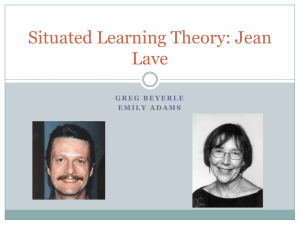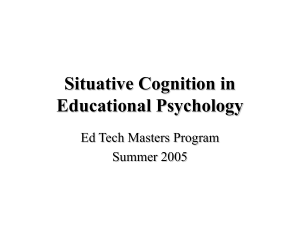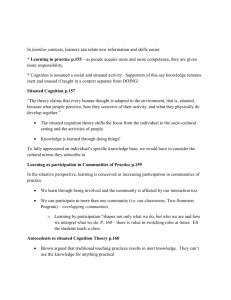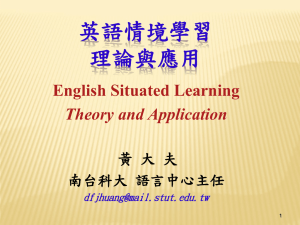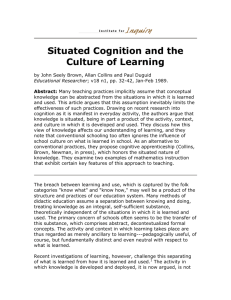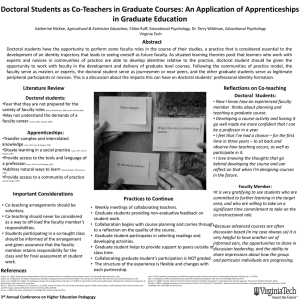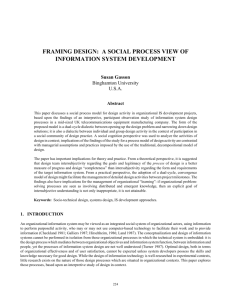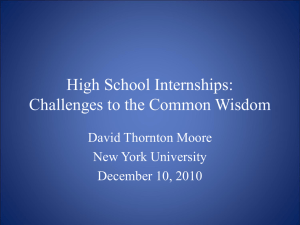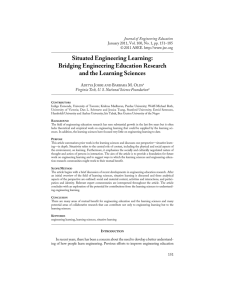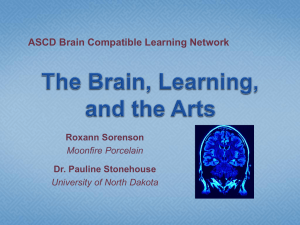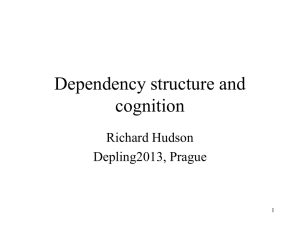Lecture notes
advertisement
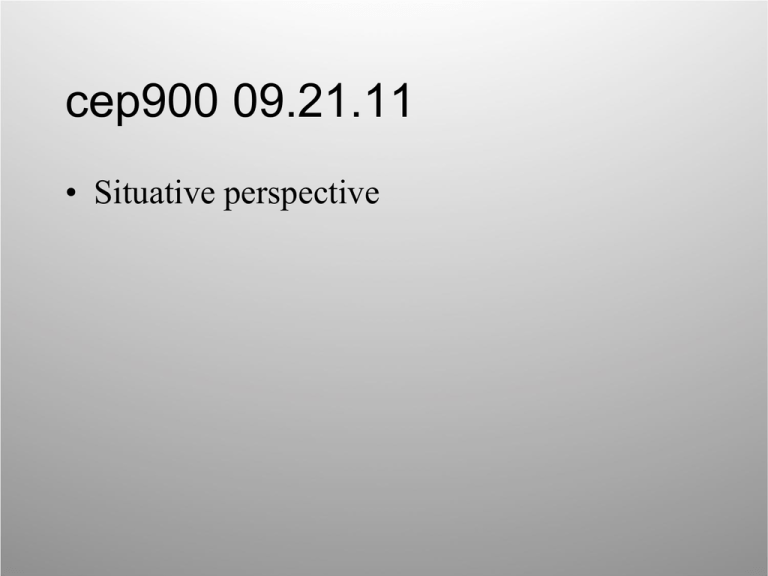
cep900 09.21.11 • Situative perspective assignments Readings Faculty guest: Dr. Cindy Okolo, Special Education Fuchs, D., Fuchs, L. S., & Stecker, P. M. (2010). The "blurring" of special education in a new continuum of general education placements and services. Kavale, K. A., Kauffman, J. M., & Bachmeier, R. J. (2008). Response-to-intervention: Separating the rhetoric of selfcongratulation from the reality of specific learning disability identification. assignments RDP Individual Meetings • Purpose of the meeting • Preparation & requirements announcements review: cognitive perspective Cognitive perspective Review of constructs Motivation situative perspective A little historical context • John Seely Brown work at Xerox – the problem of training • Emergence of situative perspective also influenced by work in Literary criticism, and social anthropology (Lave & Wenger) situated cognition John Seely Brown et al., http://www.johnseelybrown.com/ Situated cognition…what does that mean? Better yet, if “situated cognition” is the answer, what was the question? (Remember constructs are created to address specific problems. What problem does “situated cognition” address?) situated cognition Bold assertions All knowledge is...like language Conceptual knowledge is similar to a set of tools Most school activity exists in a culture of its own Knowing and doing are interlocked and inseparable situated cognition Where is meaning, thinking, & knowledge? What a strange question! What are the choices? situated cognition What does “situated” mean? And, what is the difference between cognition and situated cognition? situated cognition is a construct Construct – a complex concept that has a descriptive or explanatory function • Remember constructs are created to address specific problems. What problem does “situated cognition” address? • What is the construct of situated cognition an alternative to? knowingdoing One of the central issues highlighted by the situative perspective is the relationship between knowing and doing Give examples from the reading. learning is situated…in what? “Learning from dictionaries, like any method that tries to teach abstract concepts independently of authentic situations, overlooks the way understanding is developed through continued, situated use.” (Brown, Collins, & Duguid, 1986) situative cognition constructs Ideas and terms associated with the situative perspective. How do they express situative-ness? • • • • • • Tools, activities Affordances and constraints Learning as enculturation Authentic activity Cognitive apprenticeship Students, practitioners, and “just plain folks” discussion Free discussion (an experiment!) Discuss thoughts and reactions to the situative perspective. jean lave • social anthropologist (studies how people behave in social groups, often with the goal of re-examining Western assumptions about the group) • usually long-term investigation, often as a participantobserver • helped developed the idea of situation learning and communities of practice, and legitimate peripheral participation lave & wenger • Examined five apprenticeship scenarios (Yucatec midwives, Vai and Gola tailors, naval quartermasters, meat cutters, and nondrinking alcoholics involved in AA). • led to several conclusions about the situatedness of LPP and its relationship to successful learning lave & wenger Qualities of successful learning • access to all that community membership entails, • involvement in productive activity, • learning the discourse(s) of the community including "talking about and talking within a practice," (p. 109), and • willingness of the community to capitalize on the inexperience of newcomers lave & wenger • Communities of Practice (CoP) as “groups of people who share a concern or a passion for something they do and learn how to do it better as they interact regularly.” (Where is the learning in this description?) • Examples cited: Yucatec midwives, native tailors, navy quartermasters, meat cutters and alcoholics. lave & wenger What is learning? • Learning as social participation in an authentic activity • Learning begins with legitimate peripheral participation and moves toward more central participation • Learning is often unintentional or incidental, rather than deliberate or the main goal • Motivation: desire to participate, to develop or sustain an identity as a member of the group lave & wenger Legitimate Peripheral Participation • Advocated learning as moving from peripheral to central legitimate participation in an authentic activity • LPP asserts that authentic participation can occur at all levels • LPP describes how learning might progress, what teaching might look like authentic activity Authentic activity: “ordinary practices of a culture” • The tools and activities of a domain make more sense and are more readily learned when situated in the domain from which they came. • What are these tools and activities? • Cultures: “domain culture”, “everyday culture” and “school culture” context What is context? What is not context? How can you tell? And, doesn’t this lead to a circular definition? (Remember the problems with defining “reward”?) context Even if the definition of context is circular and unclear, there is still value in considering context and learning situative research situated cognition learning in and out of school cross cultural research communities of practice (Lave & Wenger) language and learning (Heath) learning in the workplace (Brown) anthropological studies of learning (Saxe, Lave, Beach) cognition and school subjects in everyday life (Rogoff) learning in and out of school • Consider Resnick’s example and suggest your own examples that illustrate the distinctions. • learning in and out of school • individual vs. shared cognition • pure mentation vs. tool manipulation • symbol manipulation vs contextualized reasoning • generalized learning vs. situation-specific competencies discussion Seeing learning in and out of school • Think of situations you are familiar with. • Can you describe what it is that out-of-school experience gives that classroom or book learning cannot? • Give examples. • How well does Resnick’s framework describe this difference?
